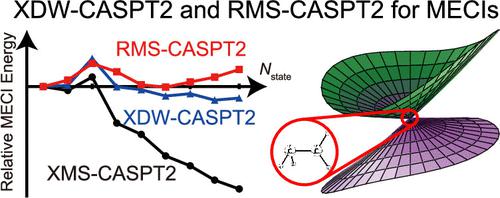当前位置:
X-MOL 学术
›
J. Chem. Theory Comput.
›
论文详情
Our official English website, www.x-mol.net, welcomes your
feedback! (Note: you will need to create a separate account there.)
Analytic First-Order Derivatives of (X)MS, XDW, and RMS Variants of the CASPT2 and RASPT2 Methods
Journal of Chemical Theory and Computation ( IF 5.7 ) Pub Date : 2022-06-14 , DOI: 10.1021/acs.jctc.2c00301 Yoshio Nishimoto 1 , Stefano Battaglia 2 , Roland Lindh 2
Journal of Chemical Theory and Computation ( IF 5.7 ) Pub Date : 2022-06-14 , DOI: 10.1021/acs.jctc.2c00301 Yoshio Nishimoto 1 , Stefano Battaglia 2 , Roland Lindh 2
Affiliation

|
Crossings between states involve complex electronic structures, making the accurate characterization of the crossing point difficult. In this study, the analytic derivatives of three complete active space second-order perturbation theory (CASPT2) variants as well as an extension of the restricted active space (RASPT2) are developed. These variants are applied to locating minimum energy conical intersections. Our results demonstrate that the three CASPT2 variants predict qualitatively similar results, but a recently developed variant, the rotated multistate CASPT2 (RMS-CASPT2), is least sensitive to the number of states considered in the calculation. We demonstrate that CASPT2 and the reference self-consistent field calculations predict qualitatively different energetics and bond lengths.
中文翻译:

CASPT2 和 RASPT2 方法的 (X)MS、XDW 和 RMS 变体的解析一阶导数
状态之间的交叉涉及复杂的电子结构,使得交叉点的准确表征变得困难。在这项研究中,开发了三个完整活动空间二阶微扰理论(CASPT2)变体的解析导数以及受限活动空间的扩展(RASPT2)。这些变体适用于定位最小能量锥形交叉点。我们的结果表明,三个 CASPT2 变体预测的结果在质量上相似,但最近开发的变体,旋转多态 CASPT2 (RMS-CASPT2),对计算中考虑的状态数最不敏感。我们证明了 CASPT2 和参考自洽场计算预测了质量上不同的能量和键长。
更新日期:2022-06-14
中文翻译:

CASPT2 和 RASPT2 方法的 (X)MS、XDW 和 RMS 变体的解析一阶导数
状态之间的交叉涉及复杂的电子结构,使得交叉点的准确表征变得困难。在这项研究中,开发了三个完整活动空间二阶微扰理论(CASPT2)变体的解析导数以及受限活动空间的扩展(RASPT2)。这些变体适用于定位最小能量锥形交叉点。我们的结果表明,三个 CASPT2 变体预测的结果在质量上相似,但最近开发的变体,旋转多态 CASPT2 (RMS-CASPT2),对计算中考虑的状态数最不敏感。我们证明了 CASPT2 和参考自洽场计算预测了质量上不同的能量和键长。











































 京公网安备 11010802027423号
京公网安备 11010802027423号